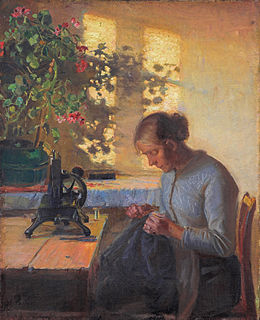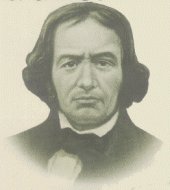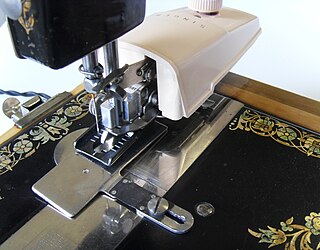This article needs additional citations for verification .(August 2014) |
The Davis Sewing Machine Company began in 1868 in Watertown, New York, and moved to Dayton, Ohio, around 1890. [1]
This article needs additional citations for verification .(August 2014) |
The Davis Sewing Machine Company began in 1868 in Watertown, New York, and moved to Dayton, Ohio, around 1890. [1]
Early Davis sewing machines, known as their "Vertical Feed" machines, did not use the conventional four motion feed, as invented by Allen B. Wilson and used in most other machines. These machines have no feed dogs at all. Instead, they have two presser feet, one of which, along with the needle bar, moves the cloth while the needle is still through the cloth. The other, larger, presser foot is used to hold the cloth stationary while the needle lifts out of the cloth and moves forward to get ready for the next stitch. While Davis called this mechanism their "Vertical Feed", sewing machines with similar mechanisms are now known as "walking foot" machines.

Later Davis machines used a more conventional feed mechanism, with a stationary presser foot and feed dogs. Davis called them "underfeed" machines.
On Oct 18, 1881, Davis Sewing Machine Co., was awarded US Pat. 248,449 for improvements over existing shuttle designs.

Around 1892, Davis started manufacturing bicycles. The Dayton Daily News indicated that the bicycle business was so successful that Davis gradually phased out production of sewing machines. The Huffman Manufacturing Company was formed as a sales outlet for Davis parts.
In 1924, the Davis Company's assets were liquidated. At that time, the company employed 1,800 workers.
This timeline of clothing and textiles technology covers the events of fiber and flexible woven material worn on the body; including making, modification, usage, and knowledge of tools, machines, techniques, crafts, and manufacturing systems (technology).

A sewing machine is a machine used to sew fabric and materials together with thread. Sewing machines were invented during the first Industrial Revolution to decrease the amount of manual sewing work performed in clothing companies. Since the invention of the first sewing machine, generally considered to have been the work of Englishman Thomas Saint in 1790, the sewing machine has greatly improved the efficiency and productivity of the clothing industry.

Sewing is the craft of fastening or attaching objects using stitches made with a sewing needle and thread. Sewing is one of the oldest of the textile arts, arising in the Paleolithic era. Before the invention of spinning yarn or weaving fabric, archaeologists believe Stone Age people across Europe and Asia sewed fur and leather clothing using bone, antler or ivory sewing-needles and "thread" made of various animal body parts including sinew, catgut, and veins.

A lockstitch is the most common mechanical stitch made by a sewing machine. The term "single needle stitching", often found on dress shirt labels, refers to lockstitch.

Machine embroidery is an embroidery process whereby a sewing machine or embroidery machine is used to create patterns on textiles. It is used commercially in product branding, corporate advertising, and uniform adornment. It is also used in the fashion industry to decorate garments and apparel. Machine embroidery is used by hobbyists and crafters to decorate gifts, clothing, and home decor. Examples include designs on quilts, pillows, and wall hangings.

Elias Howe Jr. was an American inventor best known for his creation of the modern lockstitch sewing machine.

An overlock is a kind of stitch that sews over the edge of one or two pieces of cloth for edging, hemming, or seaming. Usually an overlock sewing machine will cut the edges of the cloth as they are fed through, though some are made without cutters. The inclusion of automated cutters allows overlock machines to create finished seams easily and quickly. An overlock sewing machine differs from a lockstitch sewing machine in that it uses loopers fed by multiple thread cones rather than a bobbin. Loopers serve to create thread loops that pass from the needle thread to the edges of the fabric so that the edges of the fabric are contained within the seam.

Barthélemy Thimonnier was a French inventor, who is attributed with the invention of the first sewing machine that replicated sewing by hand. He was born in L'Arbresle, in Rhône in France.

The Huffy Corporation is a supplier of bicycles with headquarters in Dayton, Ohio.
George Phillips Huffman was an American businessman. His Davis Sewing Machine Company, which began producing bicycles in the late 19th century, was the precursor to the Huffman Manufacturing Company, a manufacturer of bicycles.

Feed dogs are movable plates which pull fabric through a sewing machine in discrete steps between stitches.

Allen Benjamin Wilson (1823–1888) was an American inventor famous for designing, building and patenting some of the first successful sewing machines. He invented both the vibrating and the rotating shuttle designs which, in turns, dominated all home lockstitch sewing machines. With various partners in the 19th century he manufactured reliable sewing machines using the latter shuttle type.
Wheeler & Wilson was an American company which produced sewing machines. The company was started as a partnership between Allen B. Wilson and Nathaniel Wheeler after Wheeler agreed to help Wilson mass-produce a sewing machine he designed. The two launched their enterprise in the early 1850s, and quickly gained widespread acclamation for their machines' designs. Both Wheeler and Wilson died in the late 19th century, resulting in the company's sale to the Singer Corporation. Shortly after, the Singer Corporation phased out Wheeler & Wilson's designs. The company sold a total of nearly 2,000,000 sewing machines during its existence.

Machine quilting is quilting made using a sewing machine to stitch in rows or patterns using select techniques to stitch through layers of fabric and batting in the manner of old-style hand-quilting. Some machines even replicate hand stitching, for example Sashiko or running stitch quilting.

The Torrington Company was a firm that developed in Torrington, Connecticut, emerging as a rename from the Excelsior Needle Company. It used a "cold swaging" technique to create sewing machine needles and other needles from cold metal, and was the largest employer in Torrington. in addition to its main facilities in Torrington, it acquired a division, located in South Bend, Indiana.
A zigzag stitch is variant geometry of the lockstitch. It is a back-and-forth stitch used where a straight stitch will not suffice, such as in reinforcing buttonholes, in stitching stretchable fabrics, and in temporarily joining two work pieces edge-to-edge.

A walking foot is a mechanism for feeding the workpiece through a sewing machine as it is being stitched. It is most useful for sewing heavy materials where needle feed is mechanically inadequate, for spongy or cushioned materials where lifting the foot out of contact with the material helps in the feeding action, and for sewing many layers together where a drop feed will cause the lower layers to shift out of position with the upper layers. A walking foot is also good for sewing materials with varying layers because it can climb up and down these layers easier than other feeding mechanisms.

A buttonholer is an attachment for a sewing machine which automates the side-to-side and forwards-and-backwards motions involved in sewing a buttonhole.

A presser foot is an attachment used with sewing machines to hold fabric flat as it is fed through the machine and stitched. Sewing machines have feed dogs in the bed of the machine to provide traction and move the fabric as it is fed through the machine, while the sewer provides extra support for the fabric by guiding it with one hand. A presser foot keeps the fabric flat so that it does not rise and fall with the needle and pucker as it is stitched. When especially thick workpieces are to be sewn, such as quilts, a specialized attachment called a walking foot is often used rather than a presser foot.
Kimball & Morton were a Glasgow-based manufacturer of domestic and industrial sewing machines active between 1867 and 1955.